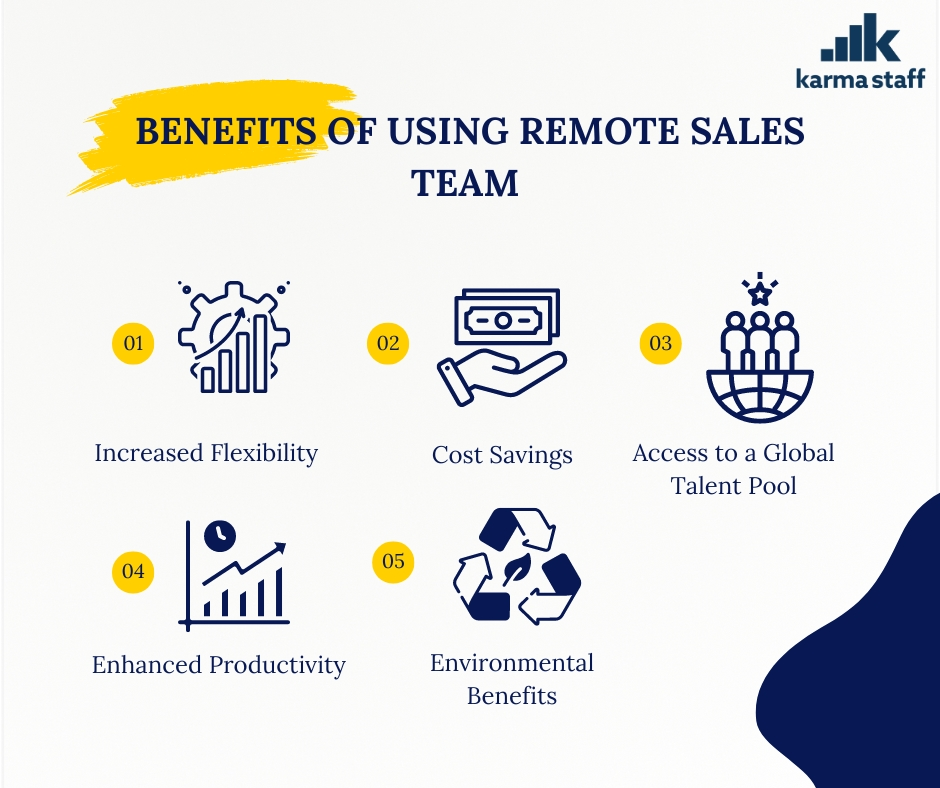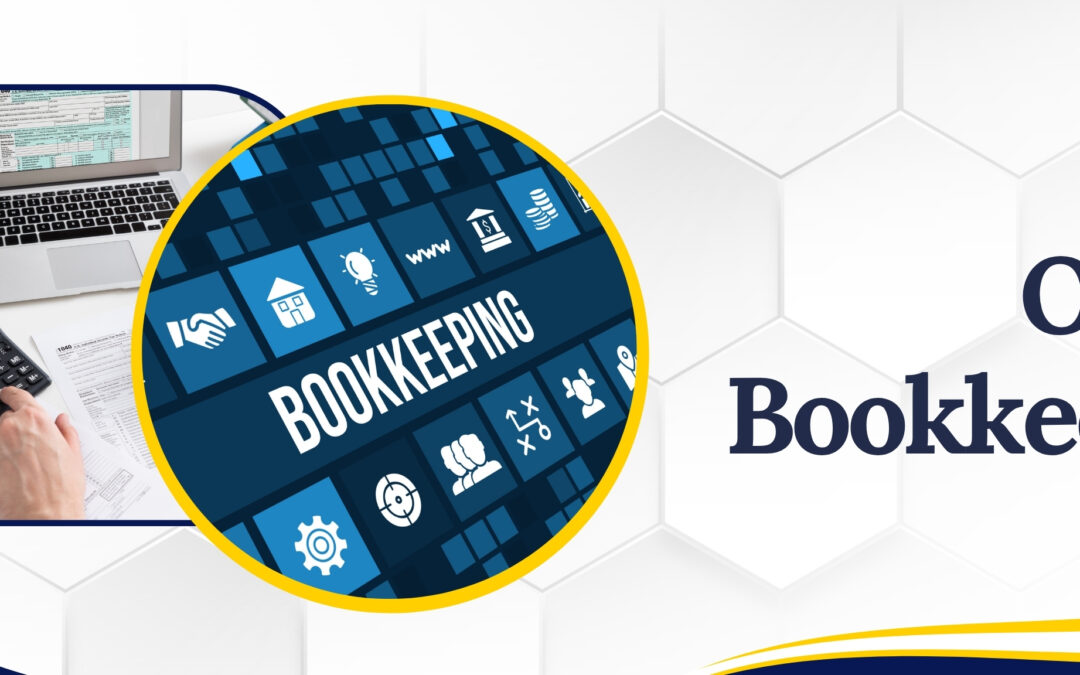What Exactly Is Remote Sales?
Remote sales refer to the process of selling products or services without the need for face-to-face interactions. Instead of meeting clients in person, sales representatives use digital tools and communication platforms to connect with prospects and customers from anywhere in the world.
The sales landscape has undergone a dramatic transformation. Traditional selling methods are evolving, and remote sales are at the forefront of this change. Here’s a closer look at what remote sales involve:
The elements of Remote Sales:
- Digital Communication: Remote sales leverage email, phone calls, video conferencing, and social media to engage with customers in different time zones, regardless of location.
- Virtual Meetings: Online tools facilitate virtual presentations, product demos, and negotiations, creating a face-to-face experience without physical presence.
- Online Sales Tools: CRM systems, e-signature platforms, and sales automation tools are essential for managing interactions, tracking leads, and closing deals efficiently.
- Content and Resources: Sharing digital content such as brochures, case studies, and product videos helps educate customers and support their decision-making process.
- Remote Collaboration: Online platforms enable remote sales teams to stay connected and coordinated, ensuring effective teamwork and communication.
- Personalization and Engagement: Sales reps use data and insights to personalize interactions, ensuring each customer feels valued and understood despite the physical distance.
In essence, remote sales specialists blend traditional selling techniques with modern technology to create a seamless and efficient user experience. By leveraging digital tools and strategies, remote sales enable businesses to reach a wider audience, reduce costs, and maintain high levels of customer engagement.
The evolution of Remote Sales from in-office sales:
The evolution of sales has been remarkable, transitioning from the age-old practice of cold calls to the sophisticated world of virtual deals. Let’s quickly walk through this transition:
- The Era of Cold Calls: In the early days of sales, cold calling was the primary method for reaching potential customers. A salesperson would dial numbers from lists, hoping to catch prospects who might be interested in their offerings. This approach was time-consuming, often met with resistance, and required a thick skin to handle rejections.
- The Rise of Email Marketing: As technology advanced, email became a powerful tool for sales. Email marketing helps businesses send specific and effective messages to potential customers. Remote sales teams could craft personalized messages and reach a larger audience with less effort compared to cold calling.
- The Introduction of CRM Systems: The development of Customer Relationship Management (CRM) systems revolutionized sales by providing a structured way to manage customer interactions and data. These systems helped remote sales teams track leads, monitor progress, and maintain relationships more effectively.
- The Digital Age and Online Presence: The Internet era brought a significant shift in sales strategies. Websites, social media, and online advertising became essential for reaching prospects. Virtual sales teams could now engage with customers through various digital channels, enhancing visibility and accessibility.
- The Advent of Video Conferencing: Video conferencing technology, such as Zoom and Skype, introduced a new dimension to sales. A salesperson could now conduct face-to-face meetings virtually, allowing for more personal interactions without the need for travel. This facilitated the building of trust and rapport with clients in a remote setting.
- Remote Sales Today: In the present scenario, remote sales are the prevailing trend. Sophisticated tools and platforms enable seamless communication, collaboration, and sales management from any location. Sales strategies now include virtual demos, webinars, and AI-driven insights, making the selling process more efficient and effective.
Must-Have Strategies for Remote Sales Success
1. Mastering Virtual Selling
Virtual selling is fundamental to achieving success in remote sales. It involves using digital tools and strategies to engage with customers and close deals without physical meetings. To master virtual selling, consider the following key strategies:
- Utilize Video call for face-to-face interactions.
- Build strong digital relationships with personalized communications and engagement
- Leverage CRM systems to track interactions and manage leads.
- Create engaging content like videos and webinars to educate prospects.
- Perfect your pitch with a confident delivery and focus on benefits.
- Optimize follow-ups with timely, automated, and personalized emails.
- Invest in continuous sales training on remote techniques and tools.
- Measure and improve performance using conversion and engagement metrics.
2. Top Online Sales Techniques That Work
In the realm of remote sales, mastering effective online techniques is essential for success. Here are a few of the best online sales strategies that work wonders every time:
- Social Selling: Use social media platforms to connect with prospects, share valuable content, and build a strong personal brand.
- Email Marketing: Craft personalized email campaigns with clear CTAs, use segmentation, and analyze performance metrics to refine your approach.
- Content Marketing: Share high-quality content like blog posts, videos, and infographics to address prospects’ pain points and showcase expertise.
- SEO: Optimize online content with relevant keywords and a user-friendly website to improve search engine rankings and attract organic traffic.
- Webinars and Online Events: Host webinars to engage your audience, demonstrate products, and share insights; promote via email and social media.
- Live Chat and Chatbots: Implement live chat and chatbots for instant support and lead capture, enhancing customer experience.
- Data-Driven Selling: Use data and analytics to inform sales strategies, track customer behavior, and optimize the sales process.
- Customer Testimonials: Showcase testimonials and case studies to build trust and credibility with potential clients.
- Influencer Partnerships: Collaborate with industry influencers to expand reach and leverage their credibility to promote your product.

3. Essential Remote Sales Tools You Can’t Ignore
In the world of remote sales, having the right tools at your disposal can make all the difference. Here are some essential remote sales tools that you simply can’t ignore:
- Customer Relationship Management (CRM) Systems: Examples are Salesforce, Hubspot, and Zoho.
- Video Conferencing Tools: Examples are Zoom, Microsoft Teams, and Google Meet.
- Sales Engagement Platforms: Examples include Outreach, SalesLoft, and Yesware.
- E-Signature Tools: Examples include DocuSign, Adobe Sign, and HelloSign.
- Collaboration and Project Management Tools: Examples include Slack, Trello, and Asana.
- Sales Analytics and Reporting Tools: Examples include InsightSquared, Clari, and Gong.
- Marketing Automation Tools: Examples include Marketo, Pardot, and ActiveCampaign.
- Lead Generation Tools: Examples are LinkedIn Sales Navigator, ZoomInfo, and Clearbit.
Challenges of Remote Sales
1. Building Trust Without a Handshake:
In remote sales, building trust without face-to-face interactions is challenging. Traditional selling relies on personal connections and in-person rapport, which are harder to establish virtually. The lack of physical presence makes it difficult to read non-verbal cues and build genuine connections, potentially prolonging the trust-building process. Customers may also be more skeptical about the authenticity of the sales call, necessitating effective methods to bridge this trust gap in a virtual environment.
2. Overcoming Tech Hiccups:
While technology is crucial for remote sales, it also introduces several challenges. Technical issues like poor internet connectivity, software glitches, and compatibility problems can disrupt meetings and presentations, causing frustration for both the remote sales team and clients. These hiccups can lead to delays, miscommunication, and lost business opportunities. Remote teams must be tech-savvy, requiring constant updates and troubleshooting to maintain productivity and client satisfaction.
3. Keeping Your Remote Sales Team Fired Up:
Keeping motivation and morale high in a remote sales team can be especially difficult. Without daily in-person interactions and camaraderie, team members can feel isolated and disengaged. The absence of spontaneous conversations can result in a feeling of disconnection from the team and company objectives. Moreover, remote work can blur the lines between personal and professional life, potentially leading to burnout. Managers must find innovative ways to keep their teams motivated, cohesive, and aligned with company objectives.
4. Data Security – Keeping It Safe and Sound:
Ensuring data security in a remote sales environment is critical. The reliance on digital tools increases the risk of data breaches and cyber threats. Remote sales teams handle sensitive information, including customer data and financial details, which can be vulnerable to cyber-attacks. Remote work environments often lack robust security infrastructure, making it easier for malicious actors to exploit weaknesses. Maintaining stringent security protocols and ensuring adherence to best practices is essential but challenging across a dispersed workforce.
5. Adapting Traditional Sales for the Digital Age:
Transitioning traditional sales techniques to the digital age poses significant challenges. A salesperson accustomed to face-to-face interactions may struggle with remote selling environments. Techniques effective in person may not translate well online, requiring a shift in strategy. Digital sales tools can be overwhelming, particularly for those less familiar with technology. Constantly updating skills and staying abreast of new trends adds complexity. Adapting to these changes while maintaining traditional sales effectiveness requires continuous learning and flexibility.
6. Embrace Digital Tools – Use CRM Systems and Sales Automation:
Adopting CRM systems and sales automation tools is crucial for remote sales but comes with challenges. Implementing these technologies requires significant time and financial investment, along with a steep learning curve. Remote sales teams need effective training, and there is often resistance to change from traditional methods. Integrating these tools into existing workflows can be complex and may disrupt established processes. Ensuring proficiency with these digital tools is essential for maximizing their benefits, but achieving this proficiency is an ongoing challenge.
Future Trends in Remote Sales
As remote sales continue to evolve, staying ahead of emerging trends is essential for future-proofing your sales strategy. Here’s a glimpse into the future trends that will shape remote sales:
- Increased Use of Artificial Intelligence (AI): AI will analyze data to provide deeper customer insights and automate routine tasks.
- Virtual and Augmented Reality: VR and AR will enable immersive product demonstrations and improve the experience of virtual meetings.
- Integration of Sales and Marketing: Unified platforms will streamline collaboration between sales and marketing teams.
- Rise of Remote-First Sales Teams: Companies will prioritize online sales, expanding their talent pool globally.
- Predictive Analytics: Advanced analytics will forecast sales trends and customer behavior more accurately.
- Personalized Customer Experiences: AI-driven personalization will tailor communications and offers to individual customer needs.
- Sales Automation: Automation tools will handle repetitive tasks, freeing up remote sales teams for strategic activities.
- Chatbots and Virtual Assistants: AI chatbots will provide instant customer support and lead generation.
- Enhanced Decision-Making: Data-driven insights will enable more informed and strategic sales decisions.
- Improved Customer Engagement: Innovative tools will foster deeper and more interactive customer relationships.
Benefits of using Remote Sales Team

- Increased Flexibility: Remote sales allow for adaptable work schedules and locations.
- Cost Savings: Companies save on expenses related to travel, office space, and in-person meetings.
- Access to a Global Talent Pool: Hiring is not limited by geography, enabling access to top talent worldwide.
- Enhanced Productivity: Remote work environments often reduce distractions and increase focus.
- Environmental Benefits: Reduced commuting and office energy consumption lead to a smaller carbon footprint.
Top 5 Best Practices for Managing Remote Sales Teams
- Set Clear Expectations: Communicate team goals, roles, and KPIs clearly to ensure everyone understands their responsibilities.
- Effective Communication: Schedule regular meetings and utilize real-time communication tools to keep everyone connected and informed.
- Promote Work-Life Balance: Allow flexible working hours and encourage regular breaks to maintain a healthy work-life balance.
- Recognize and Reward Achievements: Publicly celebrate successes and provide incentives to motivate and reward your team.
- Provide the Right Tools and Resources: Ensure your team has access to reliable tech support and all necessary materials to perform their tasks effectively.
How to Grow Your Remote Sales Team: A Step-by-Step Process
- Recruitment and Onboarding: Define clear roles and responsibilities, use remote job boards to attract top talent, create a comprehensive onboarding program, and assign mentors to new hires.
- Training and Tools: Provide continuous training for skill development and utilize CRM systems and sales automation tools to manage customer relationships and streamline processes.
- Communication and Collaboration: Use communication platforms for real-time collaboration, organize virtual team-building activities, and set SMART goals with regular performance reviews.
- Work Culture and Recognition: Promote a positive work culture by recognizing achievements, offering incentives, promoting work-life balance, and ensuring access to necessary resources.
- Data and Infrastructure: Track performance metrics with sales dashboards, use data for decision-making, personalize customer communication, and implement scalable cloud-based solutions with strong cybersecurity.
Karma Staff – Empowering Your Remote Sales Success
Embracing the remote sales revolution will not only position your business for future growth but also enhance flexibility, efficiency, and customer satisfaction. Ready to transform your sales strategy? The time to act is now.
Thank you for joining us on this journey through the future of sales. We hope this guide has provided you with valuable insights and actionable strategies to embrace the remote sales revolution. Feel free to reach out to us if you need assistance or have any questions. Let’s transform your sales approach and drive success together.







